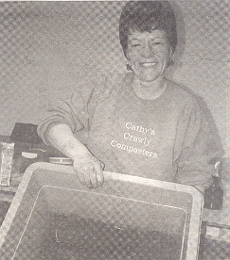There's a big difference between the dew worms that inhabit the average garden, and "red wigglers."
Dew worms live at depths of up to 6' (1.83 metres) in the soil, coming to the surface only at night to eat primarily leaf litter.
Red Wigglers penetrate only 1' (30.5 cm) into the ground, eat constantly, and are delighted to dine on just about anything organic, from leaves, to newspaper, coffee grounds and filters, tea bags, plant clippings, straw and food scraps. In fact, a pound of worms will eat half their weight in organic material each day - making them ideal for "vermicomposting."
Cathy Nesbitt, of Cathy's Crawly Composters, sings the praises of red wigglers - remarkable creatures with 5 hearts, a brain, a crop and a gizzard', that may prove to be the solution to North America's garbage crisis.
North American families produce, on average, a ton of organic garbage per year. One pound of her beloved red wigglers can handle a ton of waste annually, transforming garbage into nutrient-rich worm castings - the black gold of gardeners.
"They've been around since the dinosaurs," Nesbitt says. "Now we've got this garbage crisis, the worms' are coming to the fore... Every house needs a pound of worms!"
She is making it her mission to overcome the "ick" factor, and persuade residents to give in-home vermicomposting a try. It takes a well-ventilated bin, a layer of bedding material - Nesbitt uses a mix of shredded newspaper, ordinary garden soil, and egg shells or agricultural lime "- the proper moisture level, and temperatures of between 15.5 and 27 degrees C, to get a vermicomposting system going.
Keeping the compost covered, balancing nitrogen and carbon, and ensuring that the material doesn't get too wet, prevents problems with odor and fruit flies. If the tiny flies persist, she suggests zapping garbage in the microwave, or freezing it, to kill the eggs. After 3 to 5 months, the number of worms will double - and it will be time to remove the finished compost.
Nesbitt understands the "ick" factor, "I was afraid of worms. I found worms creepy, "she says - until she had a vision of vermicomposting as a solution to the garbage crisis, and started her business.
Nesbitt has brought her vermicomposting demonstrations to over 40,000 school children, as well as to television audiences and gardening groups; on April 11 she was guest speaker at the Gilford & District Horticultural Society. For information, visit www.cathyscomposters.com or call 905-775-9495.
Back to Articles


